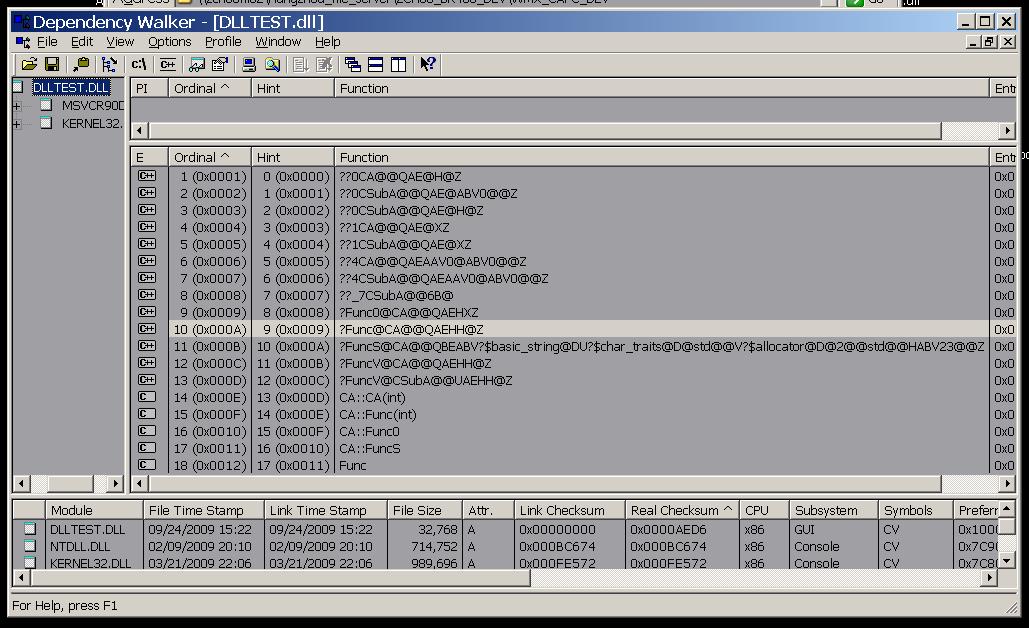使用LoadLibrary函數(shù)調(diào)用DLL中的函數(shù)的方法一般被稱為“顯式”調(diào)用,意義和使用lib的“隱式”調(diào)用相對應(yīng)。
LoadLibrary調(diào)用DLL中的函數(shù)的方法比較簡單,通過GetProcAddress獲得函數(shù)的在DLL的地址就可以訪問了,但DLL中的Class訪問就相對很復(fù)雜了(目前我就發(fā)現(xiàn)這一種顯式調(diào)用方式,哪位有其他方法么?)。一個簡單的情況就是Class的函數(shù)在調(diào)用是,其名稱是什么?還有Class的contructor函數(shù)怎么調(diào)用?下面的代碼將演示下這些問題。
這里是DLL的文件:
DllMain.h
1 #ifndef __DLLMAIN_H__
#ifndef __DLLMAIN_H__
2 #define __DLLMAIN_H__
#define __DLLMAIN_H__
3
4 #include <string>
#include <string>
5
6 #define DllExport __declspec(dllexport)
#define DllExport __declspec(dllexport)
7
8 extern "C" int DllExport Func(int x);
extern "C" int DllExport Func(int x);
9
10 extern "C" class DllExport CA
extern "C" class DllExport CA
11

 {
{
12 public:
public:
13 CA(int x);
CA(int x);
14 ~CA();
~CA();
15
16 int Func0();
int Func0();
17 int Func(int x);
int Func(int x);
18 const std::string& FuncS(int x, const std::string& str) const;
const std::string& FuncS(int x, const std::string& str) const;
19 protected:
protected:
20 int _x;
int _x;
21 };
};
22
23
24 #endif
#endif
DllMain.cpp
1 #include <iostream>
#include <iostream>
2
3 #include "DllMain.h"
#include "DllMain.h"
4
5 int Func(int x)
int Func(int x)
6

 {
{
7 return x * 10;
return x * 10;
8 }
}
9
10 CA::CA(int x)
CA::CA(int x)
11 : _x(x)
: _x(x)
12

 {
{
13 std::cout << "contructor" << std::endl;
std::cout << "contructor" << std::endl;
14 }
}
15
16 CA::~CA()
CA::~CA()
17

 {
{
18 std::cout << "destructor" << std::endl;
std::cout << "destructor" << std::endl;
19 }
}
20
21 int CA::Func0()
int CA::Func0()
22

 {
{
23 return _x;
return _x;
24 }
}
25
26 int CA::Func(int x)
int CA::Func(int x)
27

 {
{
28 return _x * x;
return _x * x;
29 }
}
30
31 const std::string& CA::FuncS(int x, const std::string &str) const
const std::string& CA::FuncS(int x, const std::string &str) const
32

 {
{
33 return str;
return str;
34 }
}
35
這里需要.def文件了,因為Class在DLL中的命名不像函數(shù)命名那么簡單,會被轉(zhuǎn)義的,像CA::Func(int)在DLL的export表中就是
?Func@CA@@QAEHH@Z,具體定義說明可參看《xxx的自我修養(yǎng)》一書。因此,這里需要使用.def文件對函數(shù)進(jìn)行重命名,下面是DllMain.def文件內(nèi)容:
1 LIBRARY TESTDLL
LIBRARY TESTDLL
2 EXPORTS
EXPORTS
3 Func = Func
Func = Func
4 CA::CA(int) = ??0CA@@QAE@H@Z
CA::CA(int) = ??0CA@@QAE@H@Z
5 CA::~CA = ??1CA@@QAE@XZ
CA::~CA = ??1CA@@QAE@XZ
6 CA::Func0 = ?Func0@CA@@QAEHXZ
CA::Func0 = ?Func0@CA@@QAEHXZ
7 CA::Func(int) = ?Func@CA@@QAEHH@Z
CA::Func(int) = ?Func@CA@@QAEHH@Z
8 ;CA::FuncS(int,std::basic_string<char>&) = ?FuncS@CA@@QBEABV?$basic_string@DU?$char_traits@D@std@@V?$allocator@D@2@@std@@HABV23@@Z
;CA::FuncS(int,std::basic_string<char>&) = ?FuncS@CA@@QBEABV?$basic_string@DU?$char_traits@D@std@@V?$allocator@D@2@@std@@HABV23@@Z
9 CA::FuncS = ?FuncS@CA@@QBEABV?$basic_string@DU?$char_traits@D@std@@V?$allocator@D@2@@std@@HABV23@@Z
CA::FuncS = ?FuncS@CA@@QBEABV?$basic_string@DU?$char_traits@D@std@@V?$allocator@D@2@@std@@HABV23@@Z
多說一句,這里.def的編寫很需要Depends(Dependency Walker)工具的支持,其是查看DLL的首選工具啊。。

編譯DLL,用下面代碼進(jìn)行測試:
LoadLib.cpp
1 #include <iostream>
#include <iostream>
2 #include <string>
#include <string>
3
4 #include <windows.h>
#include <windows.h>
5
6 //#include "DllMain.h"
//#include "DllMain.h"
7
8 #define DllExport __declspec(dllexport)
#define DllExport __declspec(dllexport)
9
10 extern "C" int DllExport Func(int x);
extern "C" int DllExport Func(int x);
11
12 extern "C" class DllExport CA
extern "C" class DllExport CA
13

 {
{
14 public:
public:
15 CA(int x);
CA(int x);
16 ~CA();
~CA();
17
18 int Func0();
int Func0();
19 int Func(int x);
int Func(int x);
20 const std::string& FuncS(int x, const std::string& str) const;
const std::string& FuncS(int x, const std::string& str) const;
21
22 private:
private:
23 int _x;
int _x;
24 };
};
25
26 typedef int (*func)(int);
typedef int (*func)(int);
27 typedef void (WINAPI *PCTOR)(int);
typedef void (WINAPI *PCTOR)(int);
28 typedef int (WINAPI *func0)(void);
typedef int (WINAPI *func0)(void);
29 typedef int (WINAPI *funcc)(int);
typedef int (WINAPI *funcc)(int);
30 typedef const std::string& (WINAPI *funcs)(int,const std::string&);
typedef const std::string& (WINAPI *funcs)(int,const std::string&);
31 typedef void (WINAPI *PDTOR)(void);
typedef void (WINAPI *PDTOR)(void);
32
33 int main()
int main()
34

 {
{
35 HINSTANCE hdll;
HINSTANCE hdll;
36 hdll = LoadLibraryA(("../DLLTEST/Debug/DLLTEST.dll"));
hdll = LoadLibraryA(("../DLLTEST/Debug/DLLTEST.dll"));
37 if(hdll != NULL)
if(hdll != NULL)
38

 {
{
39 func pf = (func)GetProcAddress(hdll, "Func");
func pf = (func)GetProcAddress(hdll, "Func");
40 std::cout << pf(10) << std::endl;
std::cout << pf(10) << std::endl;
41 CA* a = (CA*)malloc(sizeof(CA));
CA* a = (CA*)malloc(sizeof(CA));
42 PCTOR pc = (PCTOR)GetProcAddress(hdll, "CA::CA(int)");
PCTOR pc = (PCTOR)GetProcAddress(hdll, "CA::CA(int)");
43
 _asm
_asm  { MOV ECX, a }
{ MOV ECX, a }
44 pc(5);
pc(5);
45 func0 pf0 = (func0)GetProcAddress(hdll, "CA::Func0");
func0 pf0 = (func0)GetProcAddress(hdll, "CA::Func0");
46
 _asm
_asm  {MOV ECX, a }
{MOV ECX, a }
47 std::cout << pf0() << std::endl;
std::cout << pf0() << std::endl;
48 funcc pfc = (funcc)GetProcAddress(hdll, "CA::Func(int)");
funcc pfc = (funcc)GetProcAddress(hdll, "CA::Func(int)");
49
 _asm
_asm  { MOV ECX, a }
{ MOV ECX, a }
50 std::cout << pfc(10) << std::endl;
std::cout << pfc(10) << std::endl;
51 funcs pfs = (funcs)GetProcAddress(hdll, "CA::FuncS");
funcs pfs = (funcs)GetProcAddress(hdll, "CA::FuncS");
52
 _asm
_asm  { MOV ECX, a }
{ MOV ECX, a }
53 std::cout << pfs(0, std::string("hello world")) << std::endl;
std::cout << pfs(0, std::string("hello world")) << std::endl;
54 PDTOR pd = (PDTOR)GetProcAddress(hdll, "CA::~CA");
PDTOR pd = (PDTOR)GetProcAddress(hdll, "CA::~CA");
55
 _asm
_asm  { MOV ECX, a }
{ MOV ECX, a }
56 pd();
pd();
57 free(a);
free(a);
58 }
}
59 FreeLibrary(hdll);
FreeLibrary(hdll);
60
61 return 0;
return 0;
62 }
}
結(jié)果還算正常:
1 100
100
2 contructor
contructor
3 5
5
4 50
50
5 hello world
hello world
6 destructor
destructor
7
上面的代碼基本演示了DLL中Class的簡單使用,包括對contructor、destrunctor的調(diào)用,有參、無參、多參函數(shù)調(diào)用,不知道有啥缺陷,但至少Work了,嘿嘿~
由上述代碼可以看出,這種“顯式”使用DLL中的Class是非常繁瑣和危險的事情,因此我覺得能用“隱式”就不要用“顯式”,能靜態(tài)就不要用動態(tài)。。。
注意到?jīng)],代碼沒有演示繼承和虛函數(shù),那是因此我加入Virtual函數(shù),程序就會core,實在搞不定,這里也就沒法給出好的方案來,不知道哪位有啥建議么。。。
上面代碼參考了如下地址:
http://www.codeproject.com/dll/classesexportedusingLL.asp http://blog.csdn.net/jdcb2001/archive/2006/11/21/1401569.aspx